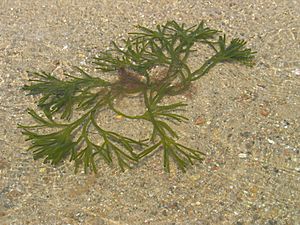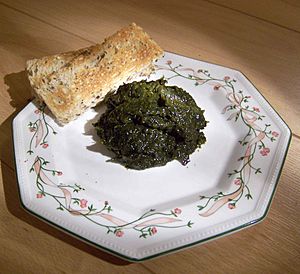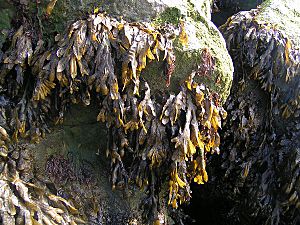Seaweed facts for kids

Seaweed is a name for many types of living things that grow in the sea. They are a kind of algae. You might know them as red, green, or brown seaweed. Just like plants, seaweed makes its own energy using sunlight through a process called photosynthesis.
Contents
Where Seaweed Lives (Ecology)
Seaweed needs two main things to grow: seawater (or at least salty water) and enough sunlight for photosynthesis. Most seaweeds also need a strong place to attach themselves.
Because of this, you often find seaweed in the littoral zone. This is the area of the sea close to the shore. It's more common to see seaweed on rocky shores than on sandy beaches.
Seaweed can live in many different places. Some grow where only sea spray touches them. Others live several meters deep in the water. In some areas, seaweed can spread miles out to sea. The main thing that stops them from growing deeper is how much sunlight they can get. The deepest seaweeds are types of kelp.
Some kinds of seaweed, like Sargassum, float freely in the water. They have gas-filled sacs that help them stay at the right depth.
Other seaweeds have learned to live in tidal rock pools. In these pools, the seaweed must handle quick changes in temperature and saltiness. They even have to survive if the pool dries out sometimes.
How We Use Seaweed
Seaweed is used in many ways. People either farm it or collect it from the wild.
Seaweed as Food

Many people around the world eat seaweed. It's very popular in East Asia, like Japan, China, and Korea. It's also eaten in places like Southeast Asia, South Africa, and parts of Europe and North America.
For example, Gim (Korea), nori (Japan), and zicai (China) are sheets of dried Porphyra seaweed. People use them in soups, sushi, or rice balls called onigiri. In the Philippines, Gamet is used to flavor soups, salads, and omelettes.
Chondrus crispus (also called 'Irish moss') is used in food. So are Kappaphycus and Gigartinoid seaweeds. In Wales, Porphyra is made into a food called laverbread. In northern Belize, seaweed is mixed with milk and spices to make a sweet drink.
Alginate, agar, and carrageenan are jelly-like products from seaweed. They are called hydrocolloids. These are often used as food additives. They help foods become thicker, hold water, or mix better. Agar is found in sweets, desserts, and molded foods. Carrageenan is used in salad dressings, diet foods, and as a preservative in meat, fish, and dairy.
Seaweed in Medicine and More


Alginates are used in wound dressings and to make dental molds. In science labs, agar is used to grow tiny living things. Other substances from seaweed are used in biomedicine. Some seaweed extracts might even help stop certain viruses.
Seaweed extract is also found in some diet pills. These pills can expand in your stomach, making you feel full.
Other Uses for Seaweed
Seaweed can be used as fertilizer for plants. It's also used in compost for gardens. Sometimes, it's buried in beach dunes to help stop beach erosion.
Scientists are looking at seaweed as a possible source for bioethanol, which is a type of fuel.
Alginates are used in many industrial products. These include paper coatings, glues, dyes, and explosives. Seaweed is also an ingredient in toothpaste, cosmetics, and paints. It can even be used to make a special kind of fabric called bio yarn.
Collecting seaweed was a popular hobby in the past and still is today. In some countries, people harvest seaweed daily to help their communities.
On the island of Læsø in Denmark, seaweed is sometimes used to build roofs on houses.
Seaweeds are also fed to animals. Sheep, horses, and cattle in Northern Europe have eaten seaweed for a long time. Adding seaweed to cattle feed can help reduce the amount of methane gas they produce.
Health Risks from Seaweed
Rotting seaweed can produce a very dangerous gas called hydrogen sulfide. This gas can make people sick, causing vomiting and diarrhea.
There is also a "stinging seaweed" called Microcoleus lyngbyaceus. It has toxins that can cause painful, burning rashes if it touches your skin. These rashes can last for days.
Threats to Seaweed
A bacterial disease called ice-ice can infect Kappaphycus (a red seaweed). It turns the seaweed's branches white. This disease has caused big losses for seaweed farms in places like the Philippines.
In some areas, sea urchin barrens have replaced kelp forests. Sea urchins are very tough and can live for over 50 years. When they are hungry, their jaws and teeth grow bigger. They can even work together to find food, eating large areas of kelp.
Images for kids
-
Ascophyllum nodosum exposed to the sun in Nova Scotia, Canada
-
Seaweed on rocks on Long Island
-
Small plots being used to farm seaweed in Indonesia, with each rectangle belonging to a different family
See also
 In Spanish: Macroalga para niños
In Spanish: Macroalga para niños












